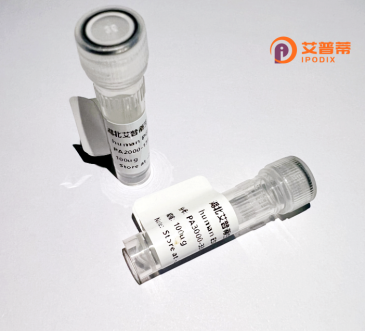
| 纯度 | >90%SDS-PAGE. |
| 种属 | Human |
| 靶点 | KBTBD8 |
| Uniprot No | Q8NFY9 |
| 内毒素 | < 0.01EU/μg |
| 表达宿主 | E.coli |
| 表达区间 | 1-601aa |
| 活性数据 | MAASADLSKS SPTPNGIPSS DPASDAMDPF HACSILKQLK TMYDEGQLTD IVVEVDHGKT FSCHRNVLAA ISPYFRSMFT SGLTESTQKE VRIVGVEAES MDLVLNYAYT SRVILTEANV QALFTAASIF QIPSIQDQCA KYMISHLDPQ NSIGVFIFAD HYGHQELGDR SKEYIRKKFL CVTKEQEFLQ LTKDQLISIL DSDDLNVDRE EHVYESIIRW FEHEQNEREV HLPEIFAKCI RFPLMEDTFI EKIPPQFAQA IAKSCVEKGP SNTNGCTQRL GMTASEMIIC FDAAHKHSGK KQTVPCLDIV TGRVFKLCKP PNDLREVGIL VSPDNDIYIA GGYRPSSSEV SIDHKAENDF WMYDHSTNRW LSKPSLLRAR IGCKLVYCCG KMYAIGGRVY EGDGRNSLKS VECYDSRENC WTTVCAMPVA MEFHNAVEYK EKIYVLQGEF FLFYEPQKDY WGFLTPMTVP RIQGLAAVYK DSIYYIAGTC GNHQRMFTVE AYDIELNKWT RKKDFPCDQS INPYLKLVLF QNKLHLFVRA TQVTVEEHVF RTSRKNSLYQ YDDIADQWMK VYETPDRLWD LGRHFECAVA KLYPQCLQKV L |
| 分子量 | 68.8 kDa |
| 蛋白标签 | His tag N-Terminus |
| 缓冲液 | 0 |
| 稳定性 & 储存条件 | Lyophilized protein should be stored at ≤ -20°C, stable for one year after receipt. Reconstituted protein solution can be stored at 2-8°C for 2-7 days. Aliquots of reconstituted samples are stable at ≤ -20°C for 3 months. |
| 复溶 | Always centrifuge tubes before opening.Do not mix by vortex or pipetting. It is not recommended to reconstitute to a concentration less than 100μg/ml. Dissolve the lyophilized protein in distilled water. Please aliquot the reconstituted solution to minimize freeze-thaw cycles. |
以下是关于重组人KBTBD8蛋白的3篇文献概览:
1. **"KBTBD8 is required for the survival of human pluripotent stem cells through stabilizing CXXC1"**
- *作者:Yang et al. (2022)*
- 摘要:研究揭示重组人KBTBD8通过与CXXC1相互作用调控多能干细胞自我更新,利用CRISPR敲除技术证明其缺失导致细胞周期停滞和凋亡。
2. **"Structural basis of KBTBD8-CUL3 complex assembly for substrate ubiquitination"**
- *作者:Sanchez et al. (2020)*
- 摘要:通过冷冻电镜解析重组人KBTBD8与CUL3泛素连接酶复合物的结构,阐明了其招募底物并介导泛素化的分子机制。
3. **"KBTBD8 interacts with proteasomal machinery to regulate oocyte meiosis"**
- *作者:Chen et al. (2018)*
- 摘要:利用重组人KBTBD8蛋白证实其在卵母细胞减数分裂中调控蛋白酶体活性,影响关键周期蛋白的降解和纺锤体形成。
---
文献覆盖KBTBD8在干细胞、泛素化通路和生殖细胞中的功能,均涉及重组蛋白的结构或功能研究。
KBTBD8 (Kelch Repeat and BTB Domain-Containing Protein 8) is a member of the BTB-Kelch protein family, characterized by its conserved BTB (Broad-Complex, Tramtrack, and Bric-à-brac) domain at the N-terminus and Kelch repeat motifs at the C-terminus. These structural features suggest roles in protein-protein interactions and substrate recognition, potentially linked to ubiquitin ligase complexes involved in protein degradation. Human KBTBD8 is implicated in critical biological processes, including gametogenesis and embryonic development. Studies highlight its involvement in regulating meiotic progression during oogenesis by interacting with components of the synaptonemal complex, ensuring proper chromosome segregation. Dysregulation of KBTBD8 has been associated with reproductive disorders and cancer progression, particularly in germ cell tumors and ovarian cancers. Recombinant human KBTBD8 protein, typically produced via heterologous expression systems (e.g., E. coli or mammalian cells), enables functional and structural studies to dissect its molecular mechanisms. Researchers utilize this recombinant form to investigate its substrate-binding specificity, post-translational modifications, and interactions with E3 ubiquitin ligases. Understanding KBTBD8’s role in cellular homeostasis and disease may reveal therapeutic targets for fertility issues or malignancies linked to its aberrant expression.
×